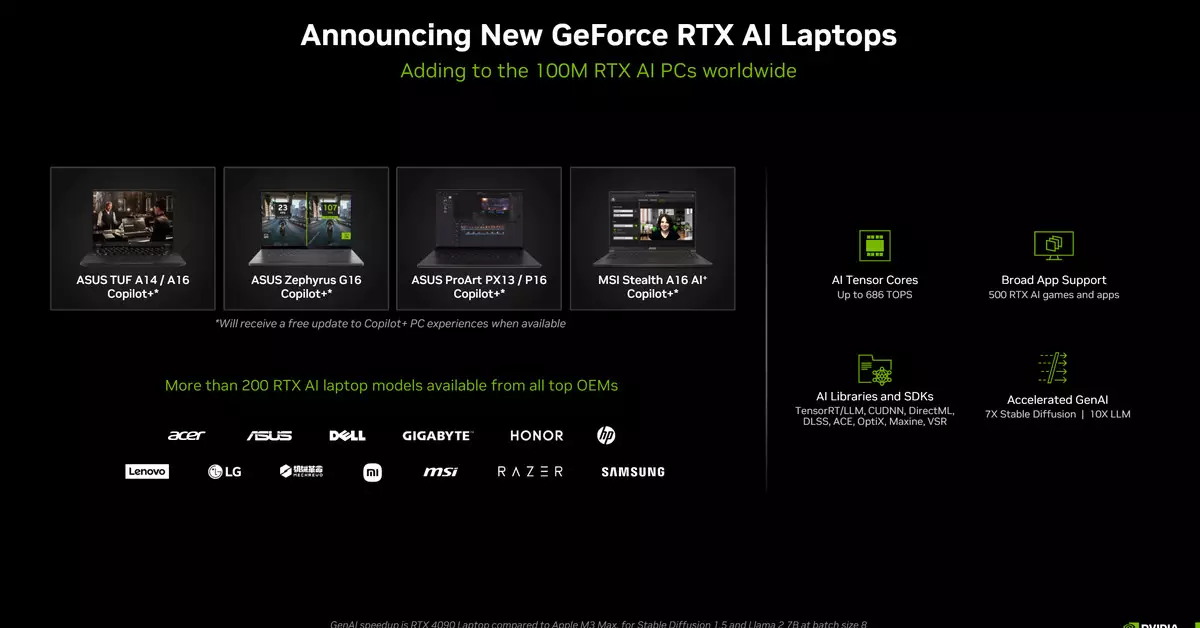Nvidia and AMD are both preparing to launch gaming laptops with AI Copilot Plus features recently announced by Microsoft for Qualcomm-powered laptops. At Computex, Nvidia hinted at the upcoming release of “RTX AI PC” laptops from Asus and MSI that will eventually incorporate Copilot Plus PC features. These new laptops will feature powerful GPUs like the GeForce RTX 4070 and energy-efficient systems-on-a-chip with Windows 11 AI PC capabilities.
AMD’s Involvement and Microsoft Exclusivity
It was confirmed by Nvidia that these laptops will be equipped with AMD’s latest Strix CPUs. Despite AMD not yet detailing its Strix laptop CPUs, it is expected to make an official announcement during its own keynote. There is a hint dropped by Nvidia that the first AMD-powered Copilot Plus PCs may not receive Microsoft’s round of AI features at launch. Instead, Nvidia mentioned that these Windows 11 AI PCs will receive a free update to Copilot+ PC experiences when they become available.
Nvidia is currently striving to maintain relevance in AI-powered tasks on laptops. While Microsoft focuses on utilizing NPUs for AI models, Nvidia is gearing up to make its GPUs essential in this AI battleground on PC. Nvidia is emphasizing its “RTX AI laptops” branding, highlighting the capability of its GPUs to efficiently handle heavy AI workloads compared to NPUs. In June, Nvidia is set to launch an RTX AI Toolkit that includes tools and SDKs for model customization, optimization, and deployment.
Collaboration with Microsoft and Developer Preview
Nvidia is working closely with Microsoft on integrating AI models into Windows 11. This collaboration aims to provide developers with easy access to GPU-accelerated small language models (SLMs) for retrieval-augmented generation (RAG) capabilities powered by Windows Copilot Runtime. Microsoft’s Windows Copilot Runtime simplifies the process for developers to incorporate AI-powered features into their apps, utilizing NPU hardware for acceleration, and soon, GPUs from Nvidia as well.
Currently, NPUs offer around 40 TOPS performance, while Nvidia’s PC GPUs can handle over 1,000 TOPS for AI acceleration. This stark contrast in performance presents developers with considerations regarding model size, power efficiency, and performance. NPUs are designed for smaller models and high power efficiency in laptops, while GPUs excel at handling larger models with superior performance in PC desktops where battery life is less critical.
The battle between Nvidia and AMD in the realm of AI capabilities for gaming laptops is intensifying. With Nvidia’s emphasis on RTX AI laptops and collaboration with Microsoft, it is evident that both companies are striving to push the boundaries of AI technology in the PC market. As the competition heats up, consumers can expect to see more advanced AI features and capabilities integrated into gaming laptops, ultimately enhancing the overall gaming experience.


Leave a Reply